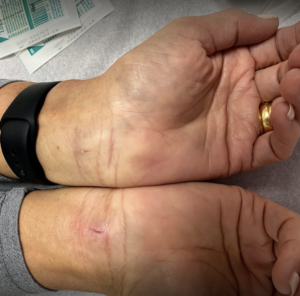Scared of Carpal Tunnel Surgery??, fear no more!!
Carpal tunnel syndrome (CTS) is one of the most common problems affecting the hand. It afflicts 4% of adults (12 million Americans) with numbness and tingling in the hands and fingers. Left untreated, it can cause long-term debilitation that can include weakness, pain and disability.
This problem develops in patients that are active with their hand, especially if they have underlying diabetes mellitus, hypothyroidism or other rheumatological problems, but it can occur in anyone throughout their life. Symptoms can present at any time of the day but are usually more pronounce at nighttime.
Initial treatment is usually non-surgical and depending on the severity level, patients might try night splints, here is a link of some of the most common splint used.
Applying Voltaren gel in the palm of the hands can sometimes help some patients with mild form of carpal tunnel syndrome. Voltaren gel is topical anti-inflammatory medication also known as diclofenac. This medication has now become an over the counter medication and easily accessible in local pharmacies without a doctor prescription.
Oral anti-inflammatory medication can also be considered in some patients, always check with your doctor if you can take these medications as some of these medications can have serious side effects depending on your health.
In some cases, a corticosteroid injection can be performed to reduce the inflammation around the nerve, this injection is called nerve hydro dissection. Check video of Dr. Gonzalez doing a carpal tunnel nerve hydro dissection.
But when traditional non-surgical treatment fails to provide relief, carpal tunnel release (CTR) surgery is recommended. CTR relieves pressure on the nerve by transecting or cutting the transverse carpal ligament, which forms the roof of the carpal tunnel to create more space for the nerve and tendons.
According to surveys, more than 12 million Americans have been diagnosed with Carpal Tunnel Syndrome and every year 2.6 million Americans get a new diagnosis of CTS. Around 6.12 million are recommended for surgery based on severity and/or failure of non-surgical treatments.
Yet only 650,000 carpal tunnel surgeries are done per year, this means that over 90 % of patients that need the surgery either decline or delay the treatment.
Why do patients decline or delay carpal tunnel release surgery??
There are 3 main reasons for this.
- Intimidated by surgery (36%)
- Recovery time (30%)
- Economics (25%)
Traditional carpal tunnel surgery involved making an incision/cut at the level of the palm to find the carpal ligament. Once the ligament is visualized, the surgeon uses a blade or scissors to dissect the ligament, once the ligament is cut the carpal tunnel is release and the nerve is no longer compressed.
This procedure is usually performed in the operating room under general anesthesia which is the main reason why patients put off the surgery. After the ligament is cut, the surgeon must close the skin and sutures are used. The hand usually takes 6 weeks to 3 months for the wound to heal. The long recovery time is the second reason for patient’s refusal to perform this surgery as many patients cannot afford to take the time off from work or daily activities. Many patients fear that this surgery will affect their financial status due to the cost of surgery and time off work.
Are there other options for carpal tunnel release??
Yes, it is called Ultrasound Guided Carpal Tunnel Release (USCTR)
Dr. Gonzalez is the first physician in the area to be trained and is now performing USCTR in south florida.
How is USCTR done?
Dr. Gonzalez will first use high resolution ultrasound machines to identify the structures of the carpal tunnel including the nerves, tendons and ligament.  He then will make a 2-3 mm incision at the level of the wrist to introduce a new revolutionary device called SX-One Micro-Knife and under direct ultrasound visualization, the carpal ligament will be cut from inside the skin.
He then will make a 2-3 mm incision at the level of the wrist to introduce a new revolutionary device called SX-One Micro-Knife and under direct ultrasound visualization, the carpal ligament will be cut from inside the skin.
Important benefits of the new procedure
- Most patients can return to work and the activities they love within 3-6 days.
- Performed in a procedure room or office setting.
- Typically performed using local anesthesia.
- Small wrist incision usually closed with an adhesive bandage.
- Reduces or eliminates need for opioids – most patients use Tylenol® or ibuprofen post procedure.
- Postoperative therapy typically not required – saving time and money.
- Immediate motion in the hand for rapid recovery.
If you want to discuss if USCTR is an option for you, call the office to speak with Dr. Gonzalez